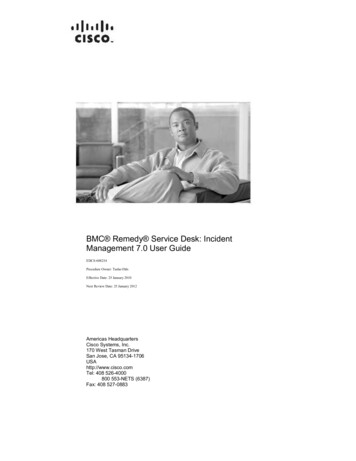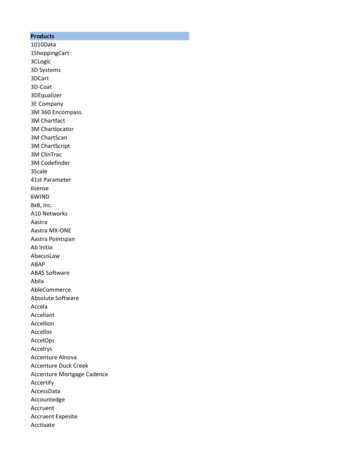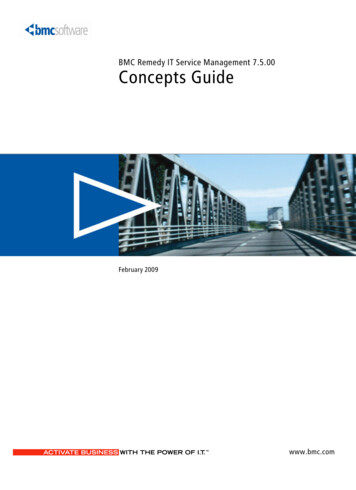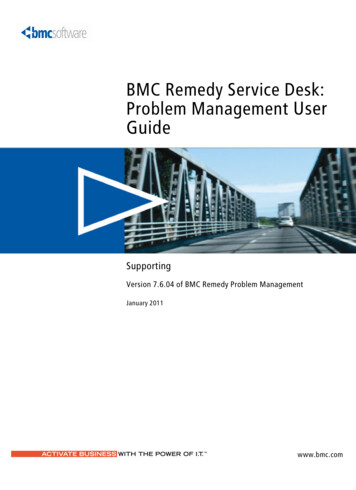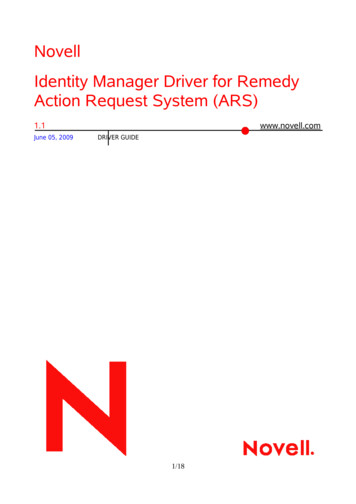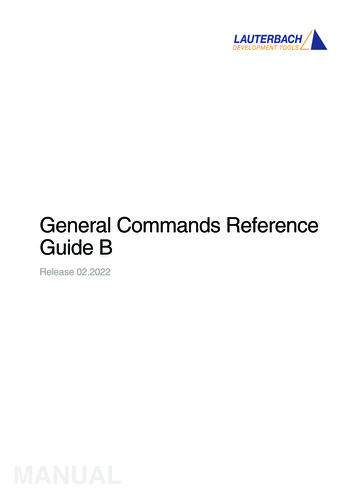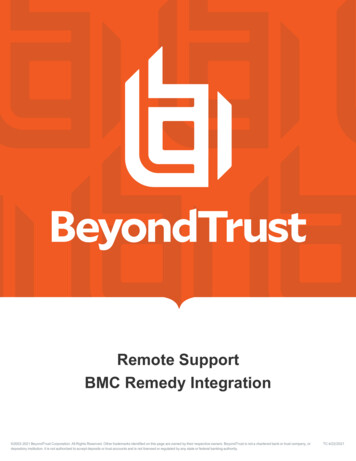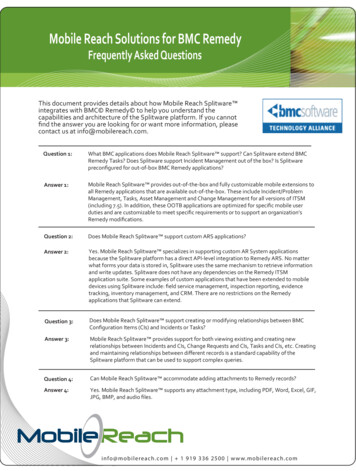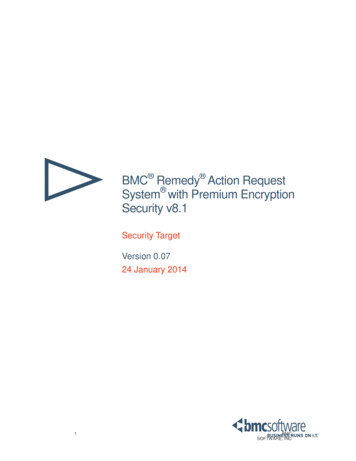
Transcription
BMC Remedy Action RequestSystem with Premium EncryptionSecurity v8.1Security TargetVersion 0.0724 January 20141BMCSOFTWARE, INC
2BMC SOFTWARE, INC
Copyright 2014 BMC Software, Inc. All rights reserved.BMC, BMC Software, and the BMC Software logo are the exclusive properties of BMC Software, Inc., are registered with the U.S. Patent and TrademarkOffice, and may be registered or pending registration in other countries. All other BMC trademarks, service marks, and logos may be registered orpending registration in the U.S. or in other countries. All other trademarks or registered trademarks are the property of their respective owners.IBM and DB2 are registered trademarks of International Business Machines Corporation.Linux is a registered trademark of Linus Torvalds.Microsoft, Windows and Windows Server are registered trademarks of Microsoft CorporationOracle, Java and Solaris are registered trademark of Oracle.UNIX is a registered trademark of The Open Group.BMC Software considers information included in this documentation to be proprietary and confidential. Your use of this information is subject to the termsand conditions of the applicable End User License Agreement for the product and the proprietary and restricted rights notices included in thisdocumentation.Restricted Rights LegendU.S. Government Restricted Rights to Computer Software. UNPUBLISHED -- RIGHTS RESERVED UNDER THE COPYRIGHT LAWS OF THEUNITED STATES. Use, duplication, or disclosure of any data and computer software by the U.S. Government is subject to restrictions, as applicable, setforth in FAR Section 52.227-14, DFARS 252.227-7013, DFARS 252.227-7014, DFARS 252.227-7015, and DFARS 252.227-7025, as amended fromtime to time. Contractor/Manufacturer is BMC Software, Inc., 2101 City West Blvd., Houston, TX 77042-2827, USA. Any contract notices should be sentto this address.3BMC SOFTWARE, INC
Document Revision HistoryDateRevisionAuthorChanges made1/4/130.01Catherine SkrbinaInitial Draft2/4/130.02Catherine SkrbinaRevised Draft. Class FDPerroneously reflected in Class FIAsection.5/17/130.03Chandra BridgesRevised Draft. Addressedevaluator comments.5/22/130.04Chandra BridgesRevised Draft. Changes to Figure1 and related information.6/7/130.05Chandra BridgesRevised Draft. Addressedevaluator comment.4/10/130.06Mark GauvreauChange to TOE name and version#24/1/140.07TMAddressed evaluator commentsBMC SOFTWARE, INC4
5BMC SOFTWARE, INC
TABLE OF CONTENTSTABLE OF CONTENTS 61SECURITY TARGET INTRODUCTION 91.11.21.31.4Security Target, TOE, and CC identification . 9Conformance claims . 9Hardware requirements . 10Conventions, terminology, and acronyms. 111.4.1Conventions . 111.4.2Terminology . 111.4.3Acronyms . 121.5TOE overview. 132TOE DESCRIPTION 142.12.1.12.1.22.1.33TOE SECURITY ENVIRONMENT 283.13.23.34Secure usage assumptions . 28Environmental assumptions . 28Threats . 29SECURITY OBJECTIVES 304.14.25Product type and evaluated component names . 14Physical scope and boundary . 15Logical scope and boundary . 24Functionalities excluded from the evaluated TOE. 27Security objectives for the TOE . 30Security objectives for the environment . 30IT SECURITY REQUIREMENTS 325.15.25.3Extended requirements definition . 32Application server authentication (FPT APP EXP). 32TOE Security Functional Requirements. 335.3.1Class FAU: Security audit . 345.3.2Class FCS: Cryptographic support . 355.3.3Class FDP: User data protection . 355.3.4Class FIA: Identification and authentication. 375.3.5Class FMT: Security management . 385.3.6Class FPT: Protection of the TSF . 405.3.7Class FTA: TOE access . 405.4TOE Security Assurance Requirements . 41BMC SOFTWARE, INC6
5.4.15.4.25.4.35.4.45.4.56Class ADV: Development. 42Class AGD: Guidance documents . 43Class ALC: Life-cycle support . 44Class ATE: Tests . 45Class AVA: Vulnerability assessment. 46TOE SUMMARY SPECIFICATION 476.16.1.16.1.26.1.36.1.46.1.56.1.6TOE security functions. 47Security Audit Data Generation. 47Cryptographic Support . 48User Data Protection . 49Identification and Authentication . 52Security Management . 54Protection of the TSF. 567PROTECTION PROFILE (PP) CLAIMS 588RATIONALE 598.18.28.38.48.58.67Security objectives rationale . 59Security requirements rationale . 628.2.1Rationale for TOE security requirements. 628.2.2Rationale for extended requirements. 65Rationale for assurance level . 65Rationale for TOE summary specification. 658.4.1TOE security functional requirements. 65Requirement dependency rationale . 66Internal consistency and mutually supportive rationale . 67BMC SOFTWARE, INC
BMC SOFTWARE, INC8
1 SECURITY TARGET INTRODUCTIONThis section presents Security Target (ST) identification information and an overview of the ST for BMC Remedy Action Request System with PremiumEncryption Security v8.1 (hereinafter referred to as BMC Remedy AR System or AR System).An ST contains the information technology (IT) security requirements of an identified Target of Evaluation (TOE) and specifies the functional andassurance security measures offered by that TOE to meet stated requirements. An ST principally defines: A security problem expressed as a set of assumptions about the security aspects of the environment, a list of threats that the product isintended to counter, and any known rules with which the product must comply (TOE Security Environment section). A set of security objectives and a set of security requirements to address the security problem (Security Objectives and IT SecurityRequirements sections, respectively).The IT security functions provided by the TOE that meet the set of requirements in the TOE Summary Specification section.The structure and content of this ST comply with the requirements specified in the Common Criteria (CC), Part 1, Annex C, and Part 3, Chapter 5.1.1Security Target, TOE, and CC identificationST Title:BMC Remedy Action Request System with Premium Encryption Security v8.1 Security TargetST Version:Version 0.07ST Date:January 24, 2014TOE Identification:BMC Remedy Action Request System with Premium Encryption Security v8.1 (English version)TOE DeveloperBMC Software, Inc.Evaluation SponsorBMC Software, Inc.CC Identification:Common Criteria for Information Technology Security Evaluation, Version 3.1 Revision 4,September 20121.2Conformance claimsThis ST and the TOE it describes are conformant to the following CC specifications: Common Criteria for Information Technology Security Evaluation Part 2: Security functional requirements, Version 3.1, Revision 4,September 2012 Part 2 ExtendedCommon Criteria for Information Technology Security Evaluation Part 3: Security assurance requirements, Version 3.1, Revision 4,September 2012 Part 3 ConformantThis ST and the TOE it describes are conformant to the following package: 9EAL2 ConformantBMC SOFTWARE, INC
1.3Hardware requirementsThe hardware requirements for any given environment depend on the size and amount of activity expected. This section describes minimum andrecommended requirements, suitable for a small organization. In most cases, BMC recommends that an analysis of the organization’s needs beperformed to determine the hardware requirements for the installation.For complete information about hardware that is compatible with AR System, refer to the Action Request System Compatibility and Support document inthe Product Availability and Compatibility pages of the Customer Support website at http://www.bmc.com/support. BMC Software recommends thatcustomers check the websites of the suppliers of the platforms and supporting components in use at their site to verify that they are still supported.Platforms that are no longer supported by the vendor are not supported by BMC Software. Common Criteria customers should also read the BMCRemedy AR System Installation information before installing BMC Remedy AR System.The minimum and recommended hardware requirements for a server running AR System or BMC Remedy Mid Tier (mid tier) are:MinimumRecommended512 MB of available RAM1 GB of available RAM800 MB of available hard disk space2 GB of available hard disk space2.8 GHz processor2.8 GHz processorNote: If you use a mid tier, BMC Remedy strongly recommends that you install it on a separate server, with the same minimum and recommendedrequirements as an AR System Server. If, however, you do combine a mid tier and an AR System installation on the same server, see therecommendations below concerning that server’s minimum and recommended hardware requirements.The hardware requirements for a single server running both AR System and the BMC Remedy Mid Tier are:MinimumRecommended1 GB of available RAM2 GB of available RAM1.5 GB of available hard disk space4 GB of available hard disk space2.8 GHz processor2.8 GHz processorThe minimum requirements for BMC Remedy Developer Studio are: Pentium 4-class 1.3 GHz or higher 512 MB memory 100 MB of free disk spaceBMC SOFTWARE, INC10
The basic AR System hardware requirements increase when you install applications that run on top of AR System. The following table displays theminimum and recommended hardware requirements for an AR System Server and one complex application in a production environment, on aMicrosoft Windows -based server. Note: Each additional complex application requires an additional 2 GB of disk space. Also, 64-bit servers must runagainst 64-bit databases.1.4MinimumRecommended2 GB of available RAM4 GB of available RAM4 GB of available hard disk space8 GB of available hard disk spaceDual 3 GHz processorDual 3 GHz processorConventions, terminology, and acronymsThis section identifies the formatting conventions used to convey additional information and terminology. It also defines terminology and the meanings ofacronyms used throughout this ST.1.4.1ConventionsThis section describes the conventions used to denote Common Criteria operations on security functional components and to distinguish text with specialmeaning.CC PART2 defines the approved set of operations that can be applied to functional requirements: assignment, refinement, selection, and iteration. Inthis ST, these operations are indicated as follows:1)The assignment operation is used to assign a specific value to an unspecified parameter, such as the length of a password. Showingthe value in square brackets [assignment value] indicates an assignment.2)The refinement operation is used to add detail to a requirement, and thus further restricts a requirement. Refinement of securityrequirements is denoted by bold text.3)The selection operation is used to select one or more options provided by the CC in stating a requirement. Selections are denoted byunderlined italicized text.4)Iterated functional components are given unique identifiers by appending a lower case letter to the component name, short name, andfunctional element name from the CC, i.e., FMT MTD.1.1a and FMT MTD.1.1bIn addition, the following general conventions are also used in this document:1.4.25)Plain italicized text is used to introduce the names of TOE components and specific concepts.6)Bold italicized text is used for emphasis.TerminologyIn the CC, many terms are defined in Section 2.3 of Part 1. The following terms are a subset of those definitions:Authentication dataInformation used to verify the claimed identity of a user.Authorized userA user who can, in accordance with the TOE Security Policy (TSP), perform an operation.External IT entityAny IT product or system, untrusted or trusted, outside of the TOE that interacts with the TOE.FormA fundamental building block in AR System. It is composed of a collection of fields. A field contains a unitof information such as an employee’s first name or location.Human userAny person who interacts with the TOE.IdentityA representation (e.g., a string) uniquely identifying an authorized user, which can either be the full orabbreviated name of that user or a pseudonym.11BMC SOFTWARE, INC
ObjectAn entity within the TOE Security Function (TSF) Scope of Control (TSC) that contains or receivesinformation and upon which subjects perform operations.RoleA predefined set of rules establishing the allowed interactions between a user and the TOE.Security functionalcomponentsExpress security requirements intended to counter threats in the assumed operational environment of theTOE.SubjectAn entity within the TSC that causes operations to be performed.TSCA set of interactions that can occur with or within a TOE and are subject to the rules of the TSP.TSFA set consisting of all hardware, software, and firmware of the TOE that must be relied upon for the correctenforcement of the TSP.TSPA set of rules that regulate how assets are managed, protected, and distributed within a TOE.UserAny entity (human user or external IT entity) outside the TOE that interacts with the TOE.1.4.3AcronymsThe following acronyms are used in this ST:APIApplication Programming InterfaceARDBCAction Request System Database ConnectivityAREAAction Request System External AuthenticationAR SystemBMC Remedy Action Request SystemCCCommon CriteriaCEMCommon Evaluation MethodologyCMConfiguration ManagementCSECCommunications Security Establishment CanadaCVECommon Vulnerabilities and ExposuresDACDiscretionary Access ControlDSODistributed Server OptionEALEvaluation Assurance LevelFDPUser Data ProtectionFIAIdentification and AuthenticationFMTSecurity ManagementFPTProtection of the TSFFSPFunctional SpecificationGUIGraphical User InterfaceHLDHigh-Level DesignISOInternational Standards OrganizationISO 15408Common Criteria 2.3 ISO StandardITInformation TechnologyJREJava Runtime EnvironmentJSPJava Server PagesLDAPLightweight Directory Access ProtocolMOFManagement of FunctionsBMC SOFTWARE, INC12
MTDManagement of TSF DataOSOperating SystemOSPOrganization Security PolicyPPProtection ProfileSARSecurity Assurance RequirementSDKSoftware Development KitSFPSecurity Function PolicySFRSecurity Functional RequirementSMSecurity ManagementSMRSecurity Management RolesSOFStrength of FunctionSTSecurity TargetTOETarget of EvaluationTSCTSF Scope of ControlTSFTOE Security FunctionalityTSFITSF InterfaceTSPTOE Security PolicyUAUUser AuthenticationUDPUser Data Protection1.5TOE overviewAR System provides a consolidated Service Process Management platform for automating and managing Service Management business processes.With its request-centric, workflow-based architecture, AR System is optimized for efficiencies in Service Management business process delivery, andincludes pre-built functionality for notifications, escalations, and approvals. AR System is compatible with existing IT infrastructures, and includes variousintegration capabilities, including support for Web Services. This evaluation did not cover the service process management functions but focused on theIA-enabled capabilities related to the definition and use of that function.13BMC SOFTWARE, INC
2 TOE DESCRIPTIONThis section provides context for the TOE evaluation by identifying the product type and describing the evaluated configuration.2.1Product type and evaluated component namesThe AR System is a development and runtime platform used to build applications that automate business processes. It also gives customers with orwithout programming experience the ability to design and customize workflow-based applications to automate business processes. Using AR System, nonprogrammers can build powerful business workflow applications and deploy them simultaneously in web, Windows, UNIX , and Linuxenvironments. One of the most common uses of AR System is to automate internal service desks.The following table identifies the AR System components and versions included in the evaluated configuration. The “abbreviated name” is used in thisSecurity Target for discussion purposes.Table 1. AR System component namesAR System component nameAbbreviated nameBMC Remedy Action Request System ServerBMC Remedy AR System, AR System Server, AR SystemserverBMC Remedy Premium Encryption SecurityPremium Security, Encryption SecurityBMC Remedy Approval ServerApproval serverBMC Remedy Email EngineEmail EngineBMC Remedy Flashboards ServerFlashboards serverServer Configuration plug-inServer Configuration plug-inWeb Services plug-inWeb Services plug-inAction Request System External Authentication LDAP plug-inAREA LDAP plug-inAction Request System Database Connectivity plug-inARDBC plug-inBMC Remedy Mid TierBMC Remedy Mid Tier, the mid tierBMC Remedy Developer StudioDeveloper StudioBMC Remedy Data ImportBMC Remedy Data ImportBMC Remedy Mid Tier Configuration ToolMid Tier Configuration ToolBMC Remedy Distributed Server OptionDSOBMC Remedy Assignment EngineAssignment EngineBMC Atrium IntegratorAtrium IntegratorBMC SOFTWARE, INC14
2.1.1Physical scope and boundaryThe TOE consists of BMC Remedy Action Request System (AR System), with BMC Remedy Premium Encryption Security. The TOE is the base BMCRemedy AR System platform and does not include workflow-based applications that are developed and run on the platform. AR System consists ofserver and client components. Table 2 lists the components of AR System that are included in the TOE.The TOE does not include the hardware, database, operating systems, email servers, or directory service protocols with which or on which the TOEcomponents run, and also does not include third-party components of the mid tier, such as a web server, JSP servlet engine, or browser. However,these components are described in this section where required, to illustrate the physical scope and boundary of the TOE.The TOE architecture provides mechanisms for its own self-protection, including: Encrypted communications between components of the TOE Controlled access to all AR System data and controlled objects by means of security attributes associated with the human user (user nameand group membership) and object permissions associated with all AR System controlled objects Required identification and authentication of all users, control of session establishment, and association of the user security attributes withthe session Security roles including authorized administrator and authorized subadministrator Limitation of the management of the TSF to the authorized security roles Authentication of automated TOE server components (application servers) Audit data generation, including user identity associationIn addition to its own mechanisms for self protection, the components of the TOE are dependent upon features of their operational environment assummarized in each component description below.AR System is built on a multi-tiered architecture (Figure 1) that includes the server tier, the mid tier, and the client tier. In addition to a three-tierdeployment model, the architecture may include a two-tier deployment model such as a server tier and a mid tier.15BMC SOFTWARE, INC
Figure 1. BMC Remedy AR System multi-tiered architectureBMC SOFTWARE, INC16
2.1.1.1Server tierThe server tier consists of the AR System Server, along with several application servers that provide specialized functionality, including the ApprovalServer, the Email Engine, the Flashboards server, and the Assignment Engine. These application servers provide commonly used services to ARSystem applications, such as workflow approvals, automated notifications, and graphics that illustrate system status and history. The ServerConfiguration plug-in will be installed with the AR System Server, and is used to issue API calls to the AR System Server for configuration. If the ActionRequest System External Authentication (AREA) LDAP plug-in or the AR System Database Connectivity (ARDBC) plug-in is used, it is also part of theserver tier. If the Web Services plug-in is used, it is also a part of the server tier. The Distributed Server Option (DSO) enables administrators toautomatically transfer requests between AR System Servers and to keep requests synchronized across multiple AR System Servers.BMC Remedy Action Request System Server. The BMC Remedy Action Request System Server (AR System Server) is a required component thatis the core of AR system. The AR System Server is a set of processes that run on the host machine. The server implements workflow and controlsworkflow logic, controls user access to AR System and the database from AR System client applications, and controls the flow of AR System data intoand out of the database. All APIs and server objects that make up AR System, including forms, menus, active links, filters, and escalations, are installedwith the AR System Server executable.The AR System Server can be installed on UNIX, Linux, or Windows platforms. The AR System Server database abstraction layer makes the ARSystem database-independent, so it can operate with most popular databases, such as Oracle , MySQL, Microsoft SQL Server, and IBM DB2 .The server processes have no direct user interface. They communicate with AR System clients and the application servers through an application programming interface (API), which includes both C and Java API libraries. The server and its API libraries implement the majority of the securityfunctionality. In addition, the server processes are protected by operating system access rights to the computer that hosts the AR System Server. Theserver executables, configuration files, log files, and other associated files are protected by operating system file and directory permissions set by theadministrator. The AR System Server is also protected by controlled physical access to the facilities housing the server tier and mid tier components ofthe TOE.Server Configuration plug-in. The Server Configuration plug-in is a separate instance of the ARDBC plug-in that will be installed with the AR SystemServer. which will issue API calls to the AR System Server. All communication to the AR System Server will be encrypted using the BMC RemedyPremium Encryption Security.BMC Remedy Approval Server. The Approval Server is an application server component that adds approval functions to existing applications toautomate business rules. The Approval Server is a set of pre-defined AR System workflow that can be added to any AR System application. It routesbusiness requests that require approval, such as manager approval of employee expenses, software and hardware change requests, and so on, along adefined path to gather the required approvals or rejections.The evaluation addressed the limits on the security-related configuration of the Approval Server and its functions, but those functions were not moredeeply analyzed.The Approval Server runs as an AR System plug-in, and communicates with the AR System Server through the plug-in server. The plug-in server is anAR System Server process and is protected by operating system access rights to the computer that hosts the AR System and plug-in server processes.The Approval Server executables, configuration files, log files, and other associated files are protected by operating system file and directory permissionsset by the administrator, as well as by controlled physical access to the facilities housing the server tier and mid tier components of the TOE.BMC Remedy Email Engine. The Email Engine is an application server component that provides email access to the AR System Server,
ST Title: BMC Remedy Action Request System with Premium Encryption Security v8.1 Security Target ST Version: Version 0.07 ST Date: January 24, 2014 TOE Identification: BMC Remedy Action Request System with Premium Encryption Security v8.1 (English version) TOE Developer BMC Software, Inc. Evaluation Sponsor BMC Software, Inc.
